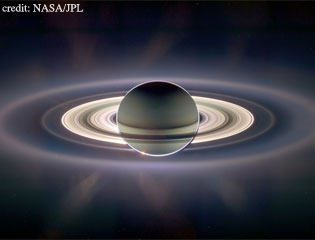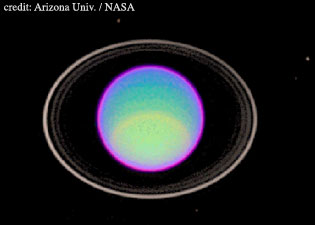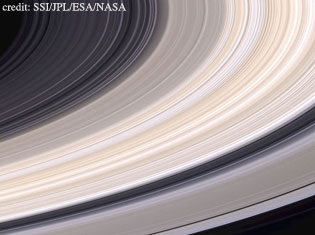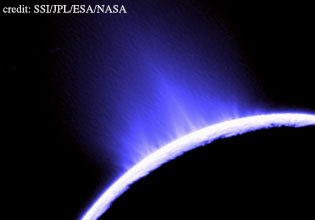
RingsRings
SUMMARY: All four jovian planets are surrounded by a set of rings. These rings are made up of rock, ice, and dust particles that range in size from microscopically small to the size of a house.
Rings Galore

(click to enlarge)
Every amateur astronomer knows how spectacular Saturn's rings look from even the smallest telescope. The glowing bands and Cassini Division can even be resolved through a set of handheld binoculars. For hundreds of years after Galileo first observed them in 1610, scientists believed Saturn to be the only planet with rings.
That myth wasn't dispelled until 1977 when a star passed behind the planet Uranus in an event called stellar occultation. To scientists' surprise, the star blinked on and off 9 times before passing behind the surface of the planet. Even though the rings weren't visible with the naked eye the stellar occultation indicated that something was there to block the light. Even more surprising to scientists was the discovery made by Voyager 1 in 1979 that Jupiter had rings. Now it's up to Neptune to complete the story.

(click to enlarge)
In the mid-1980s, there was a stellar occultation of Neptune and, just like Uranus, the starlight blinked before reaching the planet. Scientists weren't convinced that Neptune's rings completely circled the planet, but instead were smaller arcs. It wasn't until Voyager 2 passed by in 1989 that the truth became known. Neptune had a complete ring system as well.
The Rings Revealed

(click to enlarge)
From Earth, the rings look like a solid sheet of material, but they are actually made up of billions of particles of rock, ice and dust. The particles range in size from miniscule and microscopic to the size of houses and cars.
The brighter areas in the image to the right are reflecting more light from the Sun than the darker areas. The darker regions have fewer particles, so not as much light is reflected. The lighter regions are denser, so there are a lot of surfaces to reflect light.
Saturn's rings are only a few tens of meters thick, but extend almost 130,000 km above Saturn's equator. This is about a third of the distance from the Earth to the Moon. How can something extend so far, but be so thin?
Since the rings are made of billions of individual particles, you can imagine how closely packed they are. Any object with an orbit even slightly inclined to the central plane will collide with other objects just about every time it passes through. This constant collision will cause the object to slow down and eventually fall in with the rest of the pack.
How Are Rings Formed?

(click to enlarge)
There are a bunch of theories about how and why rings formed around the outer planets. Most of the focus has been placed on understanding the origin of Saturn's rings. We know that the rings are old, but the question is: How old? Thousands of years? Millions of years? Billions? The solar system is about 4.6 billion years old, and scientists are starting to explore the idea that the rings are almost as old as the solar system. That means that the rings formed when the solar system was still forming, about 4.5 billion years ago.
While the rings themselves are thought to be as old as the solar system, the particles that make up the rings are very young. Older particles have been covered by interplanetary dust, leaving them less reflective. The majority of the particles are bright, which means they haven't had time to collect dust. This suggests the ring particles get recycled somehow. Some scientists believe that the particles coalesce into moons and repeatedly break up again.

(click to enlarge)
The Cassini spacecraft recently discovered that Enceladus, one of Saturn's medium-sized moons, is providing new material to Saturn's E-ring. The E-ring is the largest planetary ring in the solar system, and seems to be continually replenished by geologic activity on Enceladus. Dust particles that are expelled fast enough from vents on the south polar region of Enceladus are ejected out of the gravitational pull of Enceladus, and added to the material in the growing E-ring. Cassini has also sent back information suggesting that material blasted off Enceladus from micrometeorites hitting its surface also helps to replenish the E-ring.
Other theories about the formation of the jovian ring systems include the possibility of a moon coming too close to the planet and breaking apart. Some of the particles could just be dust, and bits of rock and ice that were once floating around the solar system and were captured by the giant planets. Scientists are still working on a definite answer to these questions. Regardless of where they came from, they sure are beautiful.

